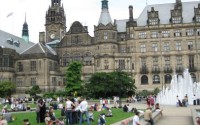A YPS full day tour of exploration in Sheffield
- Date
- 11 May 2011
- Start time
- 12:00 AM
- Venue
- Sheffield
- Speaker
- N/A

Report
by Roger Pinder
Thirty-one of us joined the trip to south Yorkshires industrial heartland, appropriately arriving in Sheffield on a Wednesday via Hillsborough and the eponymous football club. Surrounded by now-green hills, modern Sheffield still retains a degree of industrial grime and grit amidst the rejuvenated city centre and university areas and is proud of its once-premier position in the world of steel. The Sheffield Industrial Museums showcase the citys industrial story from early industrialization to modern times where Made in Sheffield remains a recognized mark of craftsmanship and quality. The day began beside one of Sheffields 4 rivers, the Don, at the Kelham Island Museum dominated by a huge Bessemer converter used worldwide to transform pig iron into steel and invented in the mid-18th century by an Englishman, Henry Bessemer. This revolutionary process allowed large-scale steel production and essentially made obsolete the old batch process of using small crucibles, which was the then mainstay of Sheffield steel production located in the valley of the river Sheaf and immortalized in the Abbeydale Industrial Hamlet Museum. The contrast between the two museums could not have been greater; Abbeydale, frozen in time, offering a unique glimpse of 18th century life at home and at work at a rural scythe and steelworks, with workers houses, waterwheels, crucible furnaces and tilt hammers, and Kelham telling the story from light trades and skilled craftsmanship to mass production during the Industrial Revolution. Lunch was taken in the Sheaf valley, at an excellent pub appropriately called the Cross Scythes, between the visits to the 2 industrial museums.
The modern city centre of Sheffield presented an entirely different prospect. While retaining some fine Victorian buildings, the 2 squares have been connected by a glass Winter Garden which is the largest temperate glasshouse in any European city centre and contains over 2000 plants including palms from China, Central America and Madagascar, and trees from Australia and Norfolk Island. Not an entirely satisfactory juxtaposition in some peoples eyes, but rather grand to others. Millennium Square is bounded by theatres, hotels and galleries, and contains the iconic spherical stainless steel water sculpture Rain. The Millennium Galleries feature changing exhibitions, and our visit coincided with an excellent Ruskin show which only partly compensated for the closure of the Graves Art Gallery for budgetary reasons.
The day ended with sunshine and a visit to the University Botanical Gardens, founded in the same year as Yorks own Museum Gardens on a similar sloping site but with glasshouses at the brow rather than a museum. The Grade II listed glass pavilions from 1836 have been restored to their former glory with the help of almost £7 million of Heritage Lottery funds, and contain a wonderful collection of specimens from different climates from around the world. At 90m long and containing thousands of panes of hand-blown glass, the pavilions are different from but certainly rival our own Yorkshire Museum in impact. The gardens, which contain the National Collections of Weigela, Diervilla and Sarcococca, were largely in full bloom and provided a vivid contrast to Sheffields industrial past and modern present.